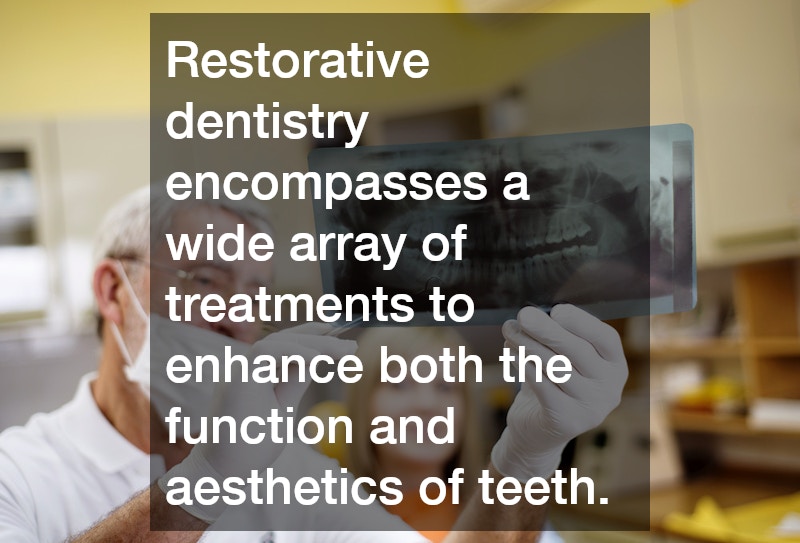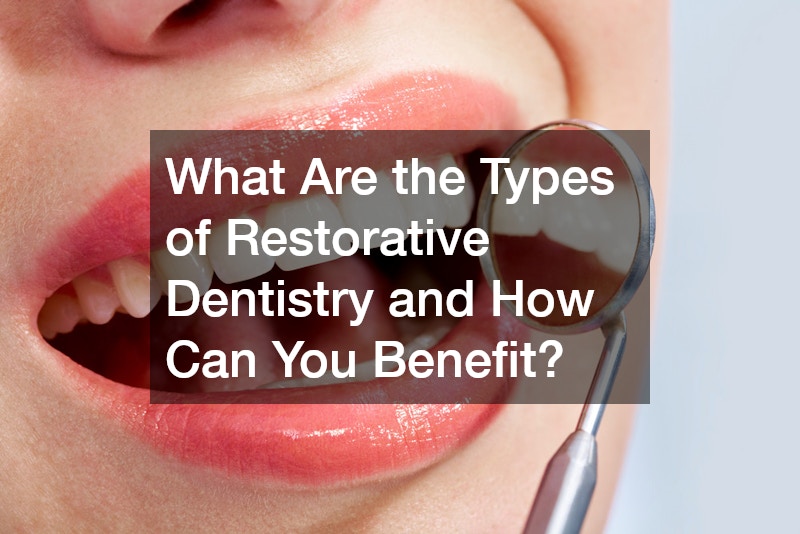
What Are the Types of Restorative Dentistry and How Can You Benefit?
Introduction
Restorative dentistry is a vital aspect of dental care focused on restoring the function, integrity, and aesthetics of damaged or missing teeth. It plays a crucial role in enhancing both oral health and quality of life, providing solutions that are both functional and visually appealing. By understanding the various types of restorative dentistry and their benefits, patients can make informed choices toward improving their dental health and overall well-being.
What is Restorative Dentistry?
Definition and Objectives
Restorative dentistry refers to the diagnosis, prevention, and treatment of oral diseases, as well as the rehabilitation of teeth to maintain functional and esthetic integrity. Its primary objectives include restoring the natural function of teeth and improving the oral health of patients. This branch of dentistry is distinct from cosmetic dentistry, which focuses primarily on enhancing the visual appearance of teeth.
The emphasis on functionality sets restorative dentistry apart from other areas of practice. By addressing issues like decay, damage, and tooth alignment, restorative procedures ensure that patients can enjoy a natural feel and use of their teeth. Ultimately, the goal is to provide comprehensive care that combines functionality with esthetic improvement.
Restorative dentistry also places a significant emphasis on planning and preventive strategies. Through careful assessment and diagnosis, dental professionals can provide treatments that not only fix existing issues but also prevent future complications. This holistic approach allows for personalized care that caters to the specific needs of each patient.
Common Procedures in Restorative Dentistry
Common procedures in restorative dentistry include fillings, crowns, bridges, dentures, and implants. Each of these treatments serves a distinct purpose, such as filling cavities, replacing missing teeth, or repairing tooth structures for improved oral health. By selecting the appropriate procedure, dentists can effectively address the individual needs of their patients.
For instance, dental fillings are used to repair minor cavities or fractures by filling the damaged areas with materials like composite resin or amalgam. On the other hand, crowns act as protective caps for teeth that require added strength and durability due to extensive damage. Both treatments aim to restore the teeth’s natural function and appearance.
Bridges and dentures are often utilized when multiple teeth are missing, ensuring that patients can maintain normal bite patterns and avoid any long-term complications. Meanwhile, dental implants offer a more permanent solution for tooth loss, providing stability and support. Each of these procedures plays an essential role in comprehensive personalized care to meet diverse patient needs.
Importance for Oral Health
Restorative dentistry is critical for maintaining oral health, as it addresses problems that can deteriorate over time if left untreated. By regularly engaging in restorative procedures, patients can prevent issues like tooth decay, gum disease, and bone loss. These procedures are instrumental in preserving the overall structure of the mouth, ensuring longevity and vitality.
Additionally, restorative dentistry can prevent the progression of damage, leading to more extensive and costly treatments in the future. Early intervention with restorative procedures reinforces the teeth’s structural integrity, preventing fracturing or loss. This proactive approach helps patients avoid serious dental problems and maintain a healthier smile.
Regular visits to the dentist for restorative treatments foster good oral hygiene and promote improved habits. By addressing existing issues and solidifying teeth, patients are empowered to practice better oral care, leading to long-term benefits. Therefore, restorative dentistry is an essential part of maintaining both immediate and prolonged oral health.
Types of Restorative Dentistry
Direct Restorations
Direct restorations involve procedures performed directly in the patient’s mouth, typically in a single visit. Dental fillings, a common form of direct restoration, are used to repair cavities and prevent further decay. Materials such as composite resins or amalgam are chosen for their strength and ability to mimic the tooth’s natural appearance.
The primary advantage of direct restorations is their efficiency in offering immediate solutions for common dental issues. Patients benefit from the swift application and restoration of their tooth’s function and appearance. This approach minimizes waiting times and allows individuals to quickly resume normal activities.
Direct restorations are cost-effective because they generally require fewer materials and appointments. By addressing minor issues before they worsen, these procedures help patients avoid more complex and expensive treatments in the future. Direct restorations, therefore, play a crucial role in maintaining a balanced and functional set of teeth, ensuring better outcomes for patients.
Indirect Restorations
Indirect restorations are customized solutions crafted outside the mouth, requiring multiple visits for application. Procedures include crowns, inlays, and onlays, each designed to address more extensive damage or decay than direct restorations can manage. These treatments provide durable, long-lasting solutions while maintaining an esthetic appeal.
The process of creating indirect restorations involves taking precise molds of the teeth, which are then sent to a dental laboratory. These molds ensure that the restoration fits perfectly and functions optimally, thus restoring confidence in the patient’s smile. This laboratory-crafted precision makes indirect restorations ideal for cases requiring structural stability and esthetic perfection.
Despite longer appointment times and a higher cost than direct restorations, the durability of indirect restorations offers a great return on investment. Their longevity and resilience against forces like chewing provide a stable restorative solution for complex dental issues. Indirect restorations protect existing teeth by distributing bite forces evenly, ensuring long-term oral health.
Full-Mouth Reconstruction
Full-mouth reconstruction refers to comprehensive treatment plans aimed at completely restoring a patient’s oral function and appearance. This procedure can combine several restorative methods, such as dental implants, crowns, and bridges, to achieve a harmonious and functional set of teeth. It is especially beneficial for patients who have experienced significant trauma or oral disease.
Patients undergoing full-mouth reconstruction receive customized treatment plans tailored to their unique needs and desired outcomes. By integrating multiple approaches, dentists can address all areas of concern simultaneously, ensuring optimal results. This holistic approach often results in an enhanced quality of life and greater satisfaction with one’s oral health.
While the process of full-mouth reconstruction can be time-intensive, the outcome is a complete transformation in dental function and appearance. Comprehensive planning by dental professionals ensures that each element of the restoration works together harmoniously for seamless functionality and esthetics. For patients with severe oral issues, this approach is essential for comprehensive rehabilitation and renewed confidence in their dental health.
Benefits of Restorative Dentistry
Improved Functionality
Restorative dentistry significantly enhances the functionality of teeth, which contributes to better chewing and speaking abilities. By repairing damaged or missing teeth, these procedures help create a balanced bite, improving overall bite efficiency. The result is a marked improvement in the daily activities and comfort of patients.
With restored teeth functionality, patients can enjoy a diverse diet, promoting better nutritional intake and overall health. Restorative treatments ensure that the teeth can withstand daily pressures without discomfort or risk of further damage. This enhanced functionality supports a healthy lifestyle and boosts the overall well-being of individuals.
The functional benefits provided by restorative dentistry also reduce the likelihood of further oral complications. Maintaining optimal function safeguards against added stress on surrounding teeth and jaw, thus preventing additional dental issues. This preventive quality makes restorative dentistry a vital component of long-term oral health management.
Aesthetic Enhancements
The aesthetic enhancements provided by restorative dentistry contribute to a more appealing and confident smile. Procedures like crowns and implants replicate the natural appearance of teeth, enhancing the visual harmony of the mouth. These treatments allow patients to attain a smile that appears both healthy and attractive.
Through the use of advanced materials, restorative procedures seamlessly blend with the existing dental structure. This integration enables the natural look desired by patients, improving their self-esteem and social interactions. The confidence gained from an improved smile can lead to enhanced personal and professional relationships.
Restorative dentistry not only addresses functional concerns but also promotes the psychological well-being of patients. A beautiful smile can lead to an improved disposition and greater overall happiness. By prioritizing both function and esthetic appeal, restorative dentistry ensures comprehensive patient satisfaction.
Long-Term Oral Health
Restorative dentistry plays a pivotal role in maintaining long-term oral health, preventing the escalation of minor issues into serious conditions. By reinforcing teeth and providing structural support, these treatments prevent problems such as decay, periodontal disease, and tooth loss. The outcome is greater resilience and longevity of the dental framework.
Early intervention through restorative procedures can reduce the need for extensive dental work later in life. By prioritizing restoration, individuals safeguard the functionality and esthetics of their teeth, thereby extending their lifespan. This proactive approach minimizes discomfort and financial burdens associated with future treatments.
By emphasizing preventive care and routine check-ups, restorative dentistry outlines a pathway toward optimal oral health. The benefits of restoration extend beyond immediate concerns, securing dental well-being for years to come. Through consistent dental care, individuals are equipped to experience the full advantages of restorative dentistry.
Conclusion
In summary, restorative dentistry encompasses a wide array of treatments designed to enhance both the function and aesthetics of teeth. By understanding the types and benefits of these procedures, patients can take proactive steps toward optimizing their oral health. Consulting with dental professionals ensures personalized advice tailored to individual dental needs, leading to informed decisions and improved outcomes.

